Home |
Back to "Mountains" |
Back to "Expeditions" |
Cho Oyu 1997 |
Map sketch |
Height diagram |
Deutsche Version |
 Slideshow |
print version (no menus) |
| Quick overview - mountains | |
| Cho Oyu | 8201 m |
Tibet - Expedition to Cho Oyu (8201 m)
April 18 - May 26, 1999
This is the personal expedition diary of Hartmut Bielefeldt and Claudia Bäumler. It is not an official report. We were both members of the Augsburg Expedition, sharing the trip to and from the base camp with Amical Alpin, but acting independently beyond the base camp.
Augsburg Expedition:
Claudia BäumlerMichael Beuter (Expedition leader)
Hartmut Bielefeldt
Petra Kluger
Sorin Nistor
Christian Rottenegger
Expedition of Amical Alpin:
Expedition leader: Robert RacklParticipants: Thomas Becherer, Erich Berger, Martin Bischoff, Johann Brandner, Frank Everts, Martine Farenza, Helmut Hackl, Gerhard Primisser, Eckhard Schmitt, Gerd Spahn, Thomas Zwahlen
Author of this text: Hartmut Bielefeldt
Contents
- Travel to Nepal, Kathmandu
- from Kathmandu to the Chinese base camp
- Chinese base camp, walk to the base camp
- first days on the mountain, setting up camp 1...
- ...and on to camp 2
- first summit attempt
- second (successful) summit attempt
- sick in the base camp
- way back to Kathmandu
- Acknowledgements, remarks, footnotes
Sunday, April 18, 1999 / Monday, April 19, 1999
Flight to KathmanduSunday afternoon we meet at Frankfurt Airport. Petra, Claudia, myself, and the Amical group fly to Kathmandu today, while Michael, Christian, and Sorin already are in Nepal. They have been there since last week in order to get some acclimatization during a short trek.
Both groups - Augsburg (6 persons) and Amical (12 persons) will make the journey from Kathmandu to the base camp together. The main difference at the mountain is that we have no high altitude porters and are responsible for our own high camp tents, setting up the high camps, and for the food for the high camps.
Two friends from our last attempt at Cho Oyu, Gerd and Martine, join us again as we try once more to reach the summit. For Gerd it is the third attempt.
After a stop in Dubai at four o'clock in the morning, we reach Kathmandu at about ten o'clock local time [1] where the two groups are welcomed by the corresponding leaders and the local agency. The road system of Kathmandu hasn't improved substantially since last time we were here, as is evident by the chaotic traffic we encounter. The rupee exchange rate is meanwhile at 66 Rs/US$, a little lower than two years ago.
Tuesday, April 20, 1999
KathmanduMost of the group had never before been in Nepal and make a sight-seeing tour to Pashupatinath and Bodnath. Since we had already seen these places, we go to Bhaktapur [2] instead. The entrance fee taken from tourists from the west is quite high (Rs. 300), but it is supposed to be used for renovation works. Here we find the highest pagoda in Nepal, and numerous temples with nice wood carvings.
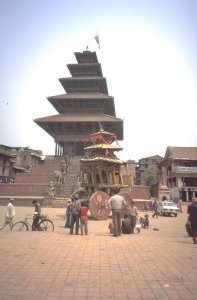 Nepal's highest pagoda |
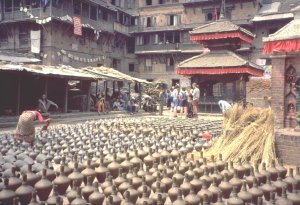 Pottery market in Bhaktapur |
The weather is quite warm, but very hazy (we see no mountains at all).
In the afternoon another little trip to Thamel, to replace the (forgotten) light gloves, and to add some food supplies.
Wednesday, April 21, 1999
Kathmandu - ZhangmuIn the morning around seven we are brought to the agency. (Thamserku has a new, quite large building outside the city). From there, we continue in a bus towards the border. Until Barabise the road is paved and in a very good state, later this quality drops quite a bit. After 4 1/2 hours, the Nepalese border village Kodari is reached (1700 m); for lunch we have Dhal Bhaat [3], and afterwards we wait for the documents allowing us to cross the border. An hour later, we are on our way walking over the "Friendship Bridge", then we travel by truck to Zhangmu (Tibetan :Khasa; 2300 m), where the immigration control takes place. This time, one can even guess a smile in the officer's face. The clock is advanced by 2 1/4 hours (Beijing time) [4], and at 17:30 we are in the hotel. From here on, the rest of the trip to the base camp is organized by Tibet Mountaineering Association (TMA), i.e. hotel and restaurant will be assigned to us.
The hotel is a real surprise, since it is very new (opened last year), it can really be awarded the name "hotel". The shower is fully integrated in the concept of the bathroom. Also the restaurant is good, the food (Chinese from now on) is very tasty.
As far as the general atmosphere in Zhangmu is concerned, nothing has changes since two years. Still the dirtiest village one could imagine. The main street is a mud road; from the houses washing water is spilled out, as well as other dirt and food remains. For important "business" the ditch beside the street is used.
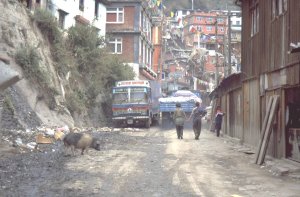
street scene
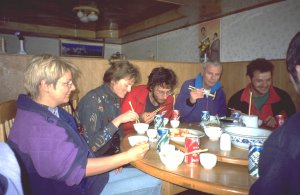
The battle around the french fries
Thursday, April 22, 1999
Zhangmu - NyalamIn the morning around ten we go to Nyalam (3700 m) by Jeep. The road is in quite a good state, even if (of course) it is far away from "western standards". There is much less snow than two years ago. In the afternoon we undertake a little acclimatization walk up to 4000 m.
We stay at the "Snow Land Hotel" in a three bed room, the beds being rather hard. But besides that there is no reason not to be satisfied. The food again is good, for lunch and dinner we have essentially the same (rice with vegetables, scambled eggs, and sometimes unidentifyable side dishes).
Friday, April 23, 1999
NyalamToday's acclimatization walk leads us into the valley towards Shisha Pangma onto a morain ridge, giving us a nice view to the neightboring mountains of Langtang Himal. Here there's plenty of water, therefore it is greener than directly around Nyalam. The only flowers, however, are sphere primulae which are visited by yellow butterflies.
For a good view, one has to be on the way rather early; around noon clouds come up from the south. Today, there is even some rain - of course this happens exactly as we spread all our things on the "roof terrace" for drying.
Saturday, April 24, 1999
Nyalam - TingriOn we go, after a short sight-seeing stop at the Milarepa monastery, we continue through an endless grey-brown desert to Lalung Leh Pass (5050 m), where we find a splendid view to Rolwaling Himal with its 7000 m peaks and to the nearest 8000 m peak, Shisha Pangma.
^
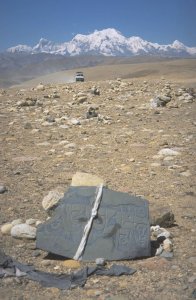 Lalung Leh Pass (5050 m), in the background Shisha Pangma |
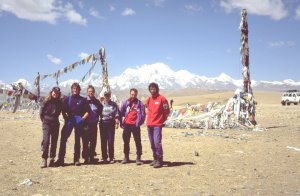 Our group. From left to right: Petra, Michael, Hartmut, Claudia, Christian, Sorin |
After another 70 km, just behind a curve a beautiful view to Cho Oyu and Everest opens up, and another 30 km further we reach Tingri (4300 m). Also here there was some progress: Instead of the comfortable, but very basic Tibetan restaurant, we now sit in a new Chinese restaurant, where of course the meals are basically the same as we have already had in Nyalam and Zhangmu. The food quality might, however, be better to estimate than in the Tibetan restaurant.
Also the - anyway very basic - toilet with the famous Everest view had vanished for a new building without any view at all.
Walking through the village, we quickly notice that in particular the children are begging much more than two years ago. Immediately we are surrounded by a crowd calling "Hello, money". This is quite annoying in the long run, and there should be better ways to help the people here to increase their prosperity than by giving money to the children (e.g. by buying handicraft articles that are produced here).
Sunday, April 25, 1999
Tingri - Chinese base campIt takes two hours to cross the thirty kilometers wide plains, always heading towards Cho Oyu. Soon Mount Everest disappears behind the closer smaller peaks. Hopefully we will see it again in three to four weeks, and then from the summit of Cho Oyu.
The Chinese base camp (drivers' base camp) is situated at 5000 m, here the Chinese liaison officer (being responsible for all expeditions) has his base. From this point, on the day after tomorrow we will go to the "real" bascamp (which is sometimes referred to as the "advanced base camp") with the Yaks, the trip taking two days.
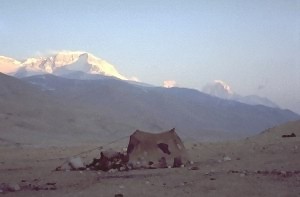
View from the Chinese base camp to Cho Oyu
For acclimatization, with increasing altitude it gets more and more important to drink a lot, even if the thirst is not that big. Therefore, on every occasion we pour incredible lots of tea into our bodies; unfortunately at least part of that wants to leave the body again in the end, mostly during the night. Even seemingly harmless things like a cough, hoarseness or diarrhea have to be treated with greatest care, since a weakened body cannot adapt to the height so well.
From here on - no more restaurant, the Sherpa cook [5] will supply us. Lunch today: beans, salad, marmelade sandwiches and mandarines. Surely we won't starve the next weeks.
Here we also have to make an acclimatization walk some meters up, passing by some old fortress ruins. At 5400 m it becomes quite windy, and we get back just in time for the afternoon tea. The weather is like the last days: in the morning cloudless, from noon on clouds come up and it becomes windy.
Besides some tufts of grass there are some small thornbushes and cushion-like plants that very much resemble the south American Llareta. Animal life consists of ravens, sparrows (or something like that), small rabbits, and ground squirrels that have dug holes all around. Sometimes one walks through the plains, you see a scurry of many many tiny guys scrambling around trying to reach their holes.
Monday, April 26, 1999
Chinese base campThis day in the Chinese base camp consists of sleeping, eating, and a little walking around. This should help for best possible adaption to the (quite high) altitude already here. Tomorrow our Yaks should come, and then we will go to the base camp (at 5700 m) in two stages. Except for a small number of people with diarrhea, a little headache or neck problems the health problems are within the usual limits, so we'll probably all be able to leave for base camp tomorrow.
In order to have some reasonable sunrise and sunset times, we change the time back to Nepal time zone, i.e. 2 1/4 hours back. Otherwise the sun would always rise at half past eight.
Tuesday, April 27, 1999
Chinese base camp - intermediate campDuring the morning, the Tibetan yak drovers distribute the loads for their yaks. Inspection of our luggage by the Chinese liaison officer results in the need of more yaks than we had reserved in advance. The problem is solved quickly, and the luggage pieces in question will be sent to base camp in one or two days. Generally the liaison officer plays a key role in the proceeding of an expedition; which, depending on mutual understanding, can have a significant effect on the factors of time and money.
After fivefold re-sorting the loads are finally fixed to the yaks that are more or less resigned to doing their task. Since the caravan is faster than we are on foot, we leave before the procedure is finished.
Todays way follows the long valley plain inwards and then upwards on the left side of the moraine of Gyabrag glacier, ascending slowly but steadily for quite a long time. After about four hours we reach our camp site of 1997. Since there is no water, the intermediate camp is established one hour further at 5400 m, where the small moraine valley becomes flat, opening the view to Cho Oyu again.
I get quite a headache after arriving there, but it quickly disappears after taking an Aspirine.
Wednesday, April 28, 1999
Intermediate camp - base campAt half past seven we're already on our way. After a flat portion, the Palung side valley is crossed with a lot of up and down, before it goes up again to the moraine edge, steeply dropping to the Gyabrag glacier on the right side. A saddle is the passage downwards (of course, loosing about 200 meters of altitude) to the camp site at the icy lake (5500 m), where two years ago we had our base camp. This time we continue another 1 3/4 hours to the Tichy camp site (5700 m).
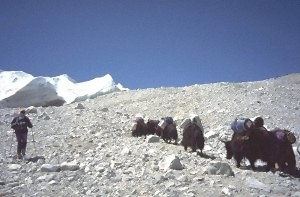
On our way to base camp
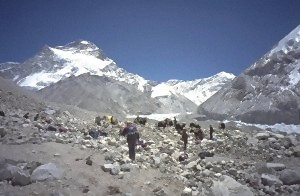
Arrival, with a direct view to our big goal.
Surprisingly, there is almost no or very little wind here. In the big morain scree rocks we establish our home for the next three and a half weeks, with a beautiful view to Cho Oyu and the Nepalese mountains behind Nangpa La [6].
All of us are not used to the height; that leads to shortage of breath. During our stay here, this will become better but never completely disappear: The highest altitude where one can acclimatize (i.e. live there continuously) is about 5300 m. At the moment, we are not acclimatized to the 5000 m; but with our acitivity in the next weeks, our bodies will acclimatize to higher and higher altitude, until this magic limit is reached. All accustomization to height beyond that point is no longer acclimatization but adaptation: an increase of pulse and breathing frequency, to compensate for the reduced oxygen supply. But the amount of necessary adaption in the very big altitudes depends on the acclimatization gained before: Sitting at 7000 m and being acclimatized for 5300 m, the need for adaptation is less than when acclimatized for 4000 m.
Independently, longer stays above 5300 m are always connected to a slow physical degradation, since we can never be acclimatized height for the entire time, and have to put considerable energy into adaptation.
Thursday, April 29, 1999
Rest day in base campSorin and Martine descend back to the Chinese base camp in order to recover better down there. Sorin cannot cure his throat infection up in the base camp, and Martine had lung problems during the night. The others have a rest day today - re-ordering and sorting the baggage. In the morning the Puja ceremony [7] takes place, carried out by Sirdar Nawang. In the afternoon, equipment and food are being sorted and our first load for the high camps for tomorrow are prepared.
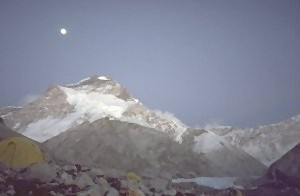
Evening in the base camp. Still the weather is perfect.
Friday, April 30, 1999
Base camp - depot - base campHans, the expedition doctor of the Amical group, has to go down to Chinese base camp due to beginning HAPE (high altitude pneumonary edema). Now they are three down there. Some of us and of the Amical members have a reconaissance walk valley-inwards up to the depot (6050 m) below killer slope [8]. That includes a long distance over the scree-covered, basically flat glacier; ups and downs over ridges and moraines sum up considerably. We leave three tents and some equipment in the depot and return to base camp. The whole action takes five hours and is finished just in time, as the afternoon clouds evolve into a snow shower.
Saturday, May 01, 1999
Base camp - camp 1 - base campSince we were told that the site of camp 1 would be quite icy (no snow at all on the glacier), today's baggage includes the heavy boots and crampons. At the depot, two tents are added, and we have a lot of fun with the "killer slope" which is - as it was two years before - very monotoneous, but it's done in two hours. It is a total of almost five hours from the base camp to here.
The site of camp 1 is situated at a horizontal ridge portion with some small depressions. The south side falls down steeply to the killer slope; therefore there's place for the tents only on the glaciated northern side. Two years ago this place was snow-covered, and it basically didn't matter where to put the tent. This year, almost everything is full of crevasses. That limits the available space.
In the last depression before the crest rises up towards the mountain and where the first fixed ropes are found, we find a nice place, well sheltered from the wind, where we can put two tents. That easier said than done, since the ice has to be flattened, and fixing the tents takes lots of stones. But lots of stones are - fortunately - lying around at the crest, not far away.
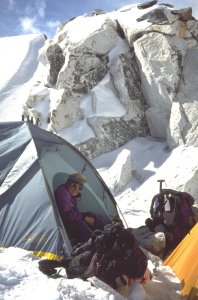
|
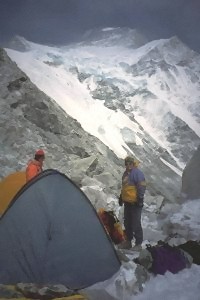
|
| Camp 1. From here, the way to camp 2 follows the crest. | |
After all that work (1 1/2 hours), having deposited the heavy climbing boots, crampons and ice axes here, we are on our way back. Meanwhile massive clouds have come up, and snow falls here and there. At half past four we arrive at base camp, and shortly after there is snowfall like at Christmas, which is joined by a fierce thunderstorm.
Frank from the Amical group celebrates his birthday today, that means a delicious cake. But besides that, we cannot complain about quality and quantity of the food that is served by our Sherpas. Up to now, we couldn't succeed in eating all the good things, not even the outstanding Pizza.
Sunday, May 02, 1999
Rest day in base campThe bad weather disappears quite hesitantly this morning. After yesterday's efforts most of us have a rest day today, only Petra and Michael go to camp 1 in order to stay overnight there (we'll do so tomorrow).
Meanwhile the shower tent has been added to our base camp. It looks like one of those toilet tents (it is yellow rather than blue like the latter ones), but in the base instead of the hole it has a plastic bottom, and in the top the shower bucket (with a tap) can be fixed. One can now jump around a bit under the pouring warm water. Considering what effort is necessary to get water here (from a glacier lake 10 minutes away), the shower tent should be used carefully, of course. Anyway, it is "nice to have".
Our basecamp is complete now. Besides several toilet tents at the edges, there are two dining tents, one for the bigger Amical group and one for us six. All 18 of us wouldn't fit into one tent; but when not all of us are in the base camp, we move closer together and use only the big tent, since it causes less work for the sherpas to prepare food for only one tent. Evenings are mostly rather short. Even if Thomas Z. is an almost inexhaustible source of jokes, we leave to our tents at about 8 o'clock, because the dining tents become uncomfortably cold.
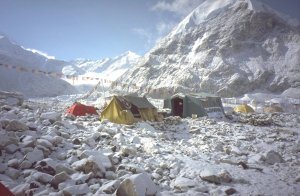
Our snowy base camp
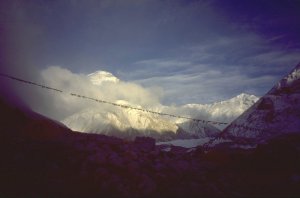
The evening is nice again.
Monday, May 03, 1999
Base camp - camp 1Let's go back up over the dull glacier, up to the depot, further up to the depot, and via beautiful killer slope to camp 1. At least everything is free of ice, so the whole way can be done with the light trekking boots.
Also today the rucksack is quite heavy (17 kg), so we reach the camp after 5 3/4 hours. But now we have essentially everything here that we will need in our daily (or nightly) life.
Not far from our tents, there is a tunnel tent inhabited by Russians. One of them immediately recognizes us, it is Ludmilla: We had met before in the Pamirs in 1993, and in the Tien Shan in 1998, where she had worked as a mountain guide.
Today the bad weather comes quite quickly again, already at half past four the snowfall begins. Only one sound of thunder, but snowfall continues until midnight. Sitting in the tent, with the need to prepare some food and lots to drink (acclimatization!), one feels somewhat restricted in the small space.
Tuesday, May 04, 1999
Camp 1 - base campThe night in camp 1 had a mediocre quality; after the second aspirin at 11 o'clock, at least the headache disappeared, and we could more or less sleep.
The morning is cloudless again, but without sun it's hard to get up. At half past seven (sunrise), it quickly gets warm and comfortable. During two hours we follow the crest towards camp 2, depositing a tent below the serac wall and declaring today's push as finished. Weather is nice, windstill and warm - would be an ideal summit day, but we are simply not acclimatized enough.
We are satisfied that during today's ascent we had no headache, apparently we have worked well on our acclimatization. The way back to camp 1 is done quite quickly due to the fixed ropes (if one masters the right rappelling technique, the biner brake, in German called "Karabinerbremse"). The killer slope is quickly done, only the glacier out to the basecamp takes an effort again, and it's boring like it always was.
In the base camp we meet Martine and Sorin who have meanwile come back again from Tingri and Chinese base camp. It was not an extremely cheap pleasure: Every overnight stay in the "Everest View" in Tingri that is organized via TMA or the liaison officer costs $32, and a jeep costs $1 per kilometer driven, i.e. $80 from Chinese base camp to Tingri round trip.
Hans apparently didn't recover well and decides not to return to base camp - to our regret. In the end, of course, everybody must know if he feels right at this place here. A direct experience with HAPE is surely something completely different than just being aware of this permanent danger. Hans will have to wait for his baggage until the scheduled date: We could immediately rent a yak that isn't needed by another expedition, but at the end of the expedition we'd get the originally scheduled number of yaks with no option to change. So we'd in fact pay for one yak twice ($ 200) - no thanks.
Wednesday, May 05, 1999
Rest day in base campOnce again a rest day, at least for us two. Petra, Michael, and Christian are shifted by one day with respect to us, and they go to camp 1 in order to establish camp 2 tomorrow. Sorin makes his first day trip to camp 1, and he'll be back already in early afternoon.
For us, this day offers - among other things - many opportunities to watch the local fauna and flora. In the base camp, the last small hard grassy cushion plants ("llareta") can be seen, and beyond here only some moss and lichens. The glacier probably cools down the environment too much to see higher plants here. Jackdaws and sparrows are even found at camp 1 (at 6400 m), in camp 1 also huge ravens (about half a meter in size), in the base camp there are pigeons, all of them quite obviously civilization followers speculating on food remains from the men's high camps. Jackdaws are seeb even at camp 2 at 7000 m. Except for the yaks, who are not here voluntarily, we have only seen mice on the ground up to now (Mice are really found everywhere...).
Thursday, May 06, 1999
Base camp - camp 1The rucksack is a bit more lightweight today than it was the last time, but that doesn't increase the entertainment value of glacier and killer slope. Today we have to carry mainly food rations for the high camps. When we arrive at camp 1 in the afternoon, Petra and Michael are not yet back from camp 2. Around four, they make it back, reporting about quite a long stretch - 5 hours. We will see tomorrow what that means for us. At least we don't have to put a tent up there, and we will have the whole day, because we plan on staying the night there and returning on Saturday.
Friday, May 07, 1999
Camp 1 - camp 2The story about the long stretch turns out to be true. For me personally it takes 7 1/2 hours, also due to the unbearable heat around noon. One can hardly miss the route from camp 1 to camp 2: The first part is secured with fixed ropes. Directly after our tent, the first two steps are rising, completely consisting of bare ice this year. After that, one follows the usually wide ridge to the base of the first ice wall which is overcome using fixed ropes and the Jumar ascenders. A very boring flat basin at 6800 m follows; here we had camp 2 two years ago. This time, we continue a considerable way further up: A steep bare ice wall of about 100 m height demands - despite the fixed ropes - quite some acrobatics, or crampons that were sharpened very recently. An endless 80 meters further up there is finally a tent - but only one, that is camp 2 of the American women's group. The "proper" camp 2 is another 80 meters higher further to the left on a plateau.
What a view we could enjoy from here, if we didn't once again sit in the usual afternoon bad weather.
Saturday, May 08, 1999
Camp 2 - camp 1 - base campConsidering the quite enormous altitude of 7000 m, astonishingly few symptoms come up: Headaches disappear after one aspirin, shortage of breath occurs only occasionally. However, the minor complaints that are not due to altitude (backache caused by the heavy rucksack, maybe a beginning sunstroke from yesterday's noon heat) eliminate the possibility of a comfortable night. And for lack of other entertainment than cooking, the nights in the high camps are usually quite long, fro 19 to 7 o'clock. At a quarter past seven in the morning the sun finally reaches a corner of the tent, we pack our stuff together and leave everything here that we don't need below (sleeping bag, cooking pot); so we won't have to carry it up again. The things can also be used by our colleagues, who can thus save some weight. Of course, that's a question of good coordination.
At half past eight we put on our harnesses and crampons. It is quite cold (-18°C), and the wind makes it more icy. Not much of a view can be seen , most mountains around us are packed in clouds. And Cho Oyu soon is the same. Fortunately the descent along the ridge is quite fast, killer slope is also done quickly, but in the long glacier walk outwards to base camp the snowfall violently catches us. In the base camp, snowfall continues during the whole evening.
At the moment there's a lot happening on the mountain, in the negative sense. Yesterday we received a radio call from the Spanish group, missing three of their members after they were on the summit. One was found quickly, he was lying in his tent in camp 2, but he didn't know anything about the others. Sherpas of the British (OTT) expedition found the second one above camp 2 the following night. The only news about the third was that two members of the Leipzig expedition had seen an unconscious person at the lower summit plateau. If that turns out true, after two nights up there there's practically no more hope for him.
Sunday, May 09, 1999
Rest day in base camp / rescue of the missing Spanish mountaineerAlmost all night it snowed. In the morning the sun is hardly visible in the milky sky; ideal weather for a rest day.
But it turns out differently: Robert, who stayed the night in camp 2 with some of the Amical people, hears somebody shouting for help around five in the morning. They found the missing Spaniard on the slope above camp 2; he had spent two nights outside at about 8000 m and is in correspondingly bad shape. Somehow he must have managed to get down with his last ounce on strength. With the help of the Amical people in camp 1 and camp 2, the Spanish and Chileans in camp 1, Leizig expedition members Ellie and Lydia (fortunately a physician and a nurse, respectively) and many Sherpas, the injured Augustin was brought down over the ice cliffs and the ridge, down the killer slope and then (on a quickly built stretcher) to the base camp. From the base camp, the operation was supported by further helpers and lots of beverages, adding up to a total of about 40 people involved in the transport - many alternately carrying the patient, others carrying luggage or distributing beverages.
After all that, the Spaniard who had suffered serious frostbite to his hands and feet could be brought to the base camp before sunset, where he had already recovered a bit.
On the other hand, there were some some who tried to escape from their responsibility using ridiculous excuses or even frank ignorance. Since I heard that indirectly, I cannot judge about the individual reasons of the people who were not helping.
A big number of helpers were engaged in this operation, some to the point of complete exhaustion. This day, of course, I didn't know that I would also owe my life to my comrades.
Monday, May 10, 1999
Rest day in base campToday is a real rest day; the weather is still quite bad. Again the morning is partially cloudy, with some snowfall here and there.
Tuesday, May 11, 1999
Rest day in base campYesterday the snowfall lasted a long time. This morning it was sunny between seven and half past eight, but soon afterwards hazy clouds came up and made life outside the tent a bit fresh.
Part of the Spanish group leaves for Kathmandu today with yaks that were sent up to the base camp before schedule. Augustin has recovered very well the last days, fortunately he had "only" severe frostbite on his hands, less severe on his feet, and general hypothermia. Meanwhile he can walk some meters again, and he can ride a yak towards the Chinese base camp. Probably a yak with exceptional load allowance due to the circumstances - usually they may not carry more than 40 kg this time of year, as indicated by the liaison officer earlier.
The other four in our group and some of the Amical group ascend to camp 1 today in order to head for camp 2 tomorrow and stay there overnight. We already settled that duty on May 8. As usual, the field separates into the early leavers (who want to arrive wth sunshine) and late leavers (who prefer to walk in the afternoon's bad weather, but stay some hours longer in the base camp at the more comfortable altitude).
Wednesday, May 12, 1999
Rest day in base campLast evening there was - how else could it be - more long-lasting snowfall. Around one o'clock the sky was completely clear, milky way could be seen above Cho Oyu. An incredible sight, the complete sky covered with stars over and over.
That is over in the morning: Everything is lying in a milky haze, and before noon snow begins to fall out of a rather thin cloud layer. In my memory, the weather two years ago was much more stable.
We had planned to start our first summit attempt today. There is none of our tents in camp 3 yet, but we can use one of the tents of the Leipzig group; they had problems to get it down again.
Taking down a well fixed high camp tent normally takes several hours, and if forced to quickly descend due to some incident it is not easy to re-ascend in order to fetch the abandoned tent, especially in the very high camps. So we will try to bring it down in the end, and we won't have to carry up our own tent; so everybody should be content with the deal.
Since it becomes apparent that the first part of the Amical group will start a summit attempt, we shift our departure to tomorrow, too. Then we won't be alone above camp 2, and the trailbreaking through the deep fresh snow will be distributed to more people. Those who made the way from camp 1 to camp 2 today had to break the trail for eight hours, through 30-40 cm of snow.
Thursday, May 13, 1999
Base camp - camp 1Claudia and I and some of the Amicals are again on the way to camp 1, the first section of the summit assault. Beatiful weather in the morning, like it was a long time ago; at noon the sky covers, and in the evening the usual snow follows.
Our only problem besides my permanent altitude cough (this makes me distribute parts of the breakfast into the landscape) is our camp 3. The Leipzig people also had asked around in the base camp for someone to take it down for a certain price. Originally nobody agreed, but meanwhile a Sherpa apparently agreed and is said to be on his way up, for US$ 400. That could have been the heavily loaded person that we met at the upper edge of killer slope. So this was our camp 3...
Friday, May 14, 1999
Camp 1 - attempt to camp 2 (storm) - camp 1 - base campThis night was the stormiest in camp 1 up to now. Though our tents are well wind-protected in a small basin, the ferocious gusts of wind strongly jerk our tent. Besides that, the storm and the snow that is thrown at the tent make a huge noise, we don't sleep too well.
As we set off at quarter to nine, the wind has calmed down more or less, and the weather doesn't look that disgusting any more. The closer we come to the first ice cliff, the darker and stormier it becomes. At the fixed ropes snow is thrown around us in the storm, and at the plateau between the two ice walls it finally becomes so terrible that we deposit the food supplies that we are carrying and turn back immediately, i.e. as soon as the wind won't press us down to the ground and when we could see the next marker flag in this snow storm.
Fighting against side winds, we proceed down the ridge to camp 1, where it suddenly becomes sunny again. That doesn't mean too much, here the storm also continues fiercely. As Eckhard, the only one who had stayed in camp 2 the night before, reports extensive storm damages of the tents up there, and since nobody can say when the storm will die down, we collectively return to the base camp.
What our remaining summit tactics now can like, will be clear only after the Amical Sherpas have a look at the tents tomorrow. On the 23rd the yaks will come for the return, that is only nine days from today.
Saturday, May 15, 1999
Rest day in base campIn the morning at the base camp, the weather is bad in the west, Cho Oyu is sunny. We can hardly remember when we had no fresh snow in the base camp in the morning. Until noon it is sunny in the west and bad at Cho Oyu.
Sherpa Chuldim has inspected the Amical tents at camp 2 - three have minor damages, and he tries to repare them, and three are unusable. As we later hear, our tent is not destroyed but in good condition. Since our schedule (and also our strength) was affected by yesterday's snow storm, we must develop a new plan for the last remaining attempt for the summit. Amical as well as we will basically start in two groups tomorrow and the following day and - provided that the weather is good - reach the summit on May 19 resp. May 20.
Instead of the usual desert, today we get a cake, inscribed "good luck".
Sunday, May 16, 1999
Rest day in base campCloudless today. Is that a reason for hope? Three days ago, however, it was like that, only to be followed by more snow. The same happens today, at noon it snows again; in the afternoon there's more sun. More and more like April.
Petra, Sorin and five of the Amicals went to camp 1 (resp. directly on to camp 2, our Swiss speed-merchants). The rest will set off tomorrow.
Monday, May 17, 1999
Base camp - camp 1As scheduled, we depart for camp 1 today. Accomodation in the camps is meanwhile clearly regulated: If everyone can proceed as planned and the weather doesn't thwart our plans, nobody will be in each other's way and we will have enough spaces in every camp.
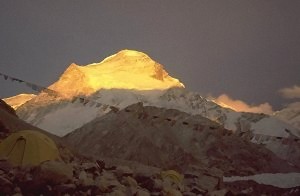
Will the weather improve now?
Tuesday, May 18, 1999
Camp 1 - camp 2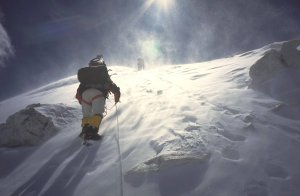 Storm above camp 1 |
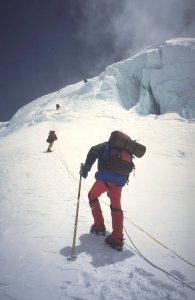 At the ice cliff |
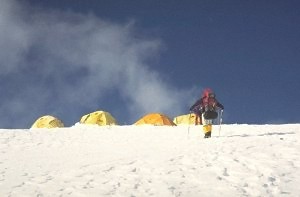 Arrival at camp 2 (7000 m) |
The day begins with a lot of wind. Enough that we first wait before the lower ice cliff and try to get information about the situation further up. Unfortunately there's no radio contact, so we continue upwards, and this turns out to be the right decision after all. Today it's very beatiful April weather: Three hours after the bitter cold and the wind, requiring all available clothing, we walk on the glacier in short sleeves through a scorching breeding heat. The friends further up have no problems setting up camp 3, so there is enough space for us in camp 2.
Wednesday, May 19, 1999
Camp 2 - camp 3During the night a violent storm rages and the summit team can not leave at three o'clock as the schedule requires. At the usual radio contact time at eight we hear that most of them want to wait another day and try again tomorrow. Some will descend after having had an uncomfortable night, so the problem of space in camp 3 decreases a little. Correspondingly we begin our ascent at nine o'clock. Until ten it is bitterly cold, but then suddenly the sun breaks through, and below us we see a sea of clouds at 7000 meters. The way is exhausting, especially the last part into the high valley of camp 3. It takes me more than four hours to climbg 350 meters. But camp 3 (7400 m) has an incredibly beatiful view.
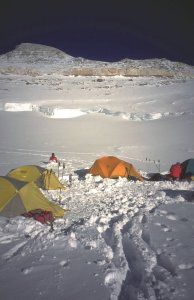
Camp 3 (7400 m)
Thursday, May 20, 1999
Camp 3 - Cho Oyu - camp 3 - camp 2Summit day. And - a miracle - a starry night and practically no wind. Shortly after three a procession of headtorches slowly makes its way up. The route leads sometimes steeply up the slope, but these parts are secured with fixed ropes. After three hours, the yellow band is reached, a steep step consisting of harder rock and going through the whole slope. Shortly before I meet Sorin, who apparently had left his jumar ascender down trusting some reports from the Austrian expedition that it wouldn't be needed. He had tried to move up the fixed ropes with his hands using the lightweight gloves, and failed. It is -20°, but it feels colder in the dark. At the easiest spot the yellow band means some meters of climbing at the fixed ropes; beyond that the slope lies back and the rest of the way way can be seen.
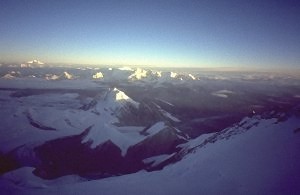 A beatiful morning. At the horizon Shisha Pangma, 100 km far. |
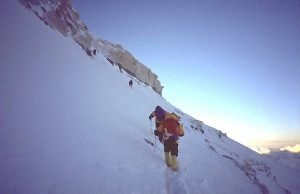 Soon we'll come to the yellow band. |
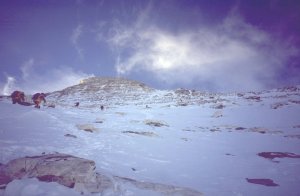 Further up, the way becomes easy again. |
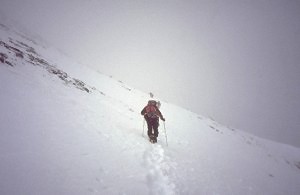 Soon we are walking through the fog. |
Fortunately the area is not as snow-free as in the beginning of our stay. Walking in the snow is better than on the scree. Keeping right, we reach the lower snow field. Between the single groups meanwhile large distances have evolved. The top consists of our two Swiss, then Chuldim, Michael, Claudia, Martine, und Frank. The rear group consists of Eckhard, Helmut, and me. Later Thomas comes from below, quickly overtaking our group. The view is beautiful this morning, even though with time more and more clouds evolve. It slowly becomes warmer again, feeling comes back to fingers and toes. Real warmth doesn't come up, however, because the cap of my thermos is frozen. Interestingly, the same happened to Eckhard's thermos (it's the same "quality brand").
After the lower snow field some scree bands must be passed, until finally the summit snow field appears. The real summit is at the other end, still about an hour to go. Claudia and Michael had a good view of Everest; as I arrive there, the view is almost completely gone, and the summit can be distinguished just by a tiny summit cross in the snow and prayer flags around it. The ascent took ten hours; in the upper part it was slow but in no way worrying. At least I could make 20 steps between the breathing stops.
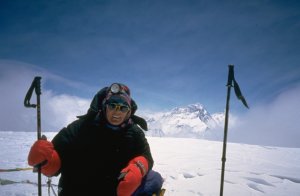
Claudia on the top, in the background Mount Everest and (behind the ski pole) Lhotse.
Together with Eckhard and Helmut I begin the way back after half an hour on the summit. The endless plateau gives an impression of endless remoteness, and we are happy to reach the first rocks again. Except for the yellow band, the whole way is simple terrain; nevertheless the descent becomes more and more arduous (dehydration?). Chuldim comes up a bit from camp 3, bringing beverages; afterwards things run better again, but still somewhat slow. At 18.45 I am back in camp 3, the descent took 5 1/2 hours.
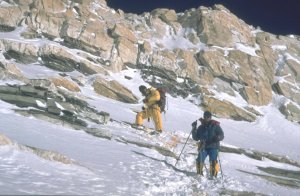
During descent, below the yellow band
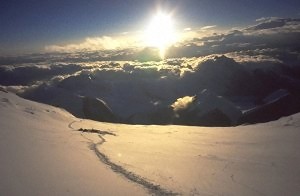
Soon camp 3 is reached again.
Since the camp is already dismantled, we continue to camp 2, and that makes sense because of the lower altitude. Michael accompanies me, since the others went on ahead. After two endless hours through the darkness of the night camp 2 (7000 m) is reached.
Friday, May 21, 1999
Camp 2 - camp 1 - base camp (descent / transport)During the night I could hardly sleep, due to real or imagined breathing problems. In the morning I am in such a bad shape that my colleagues have to fetch the oxygen bottle from the Sherpas' tent. Walking works more or less, but things like attaching the crampons to the boots make major coordination problems. As fast as possible (as fast as simply possible for me) we go down, I continue taking oxygen. My friends help me belaying me over the steep sections, but in the flatter regions I have to walk on my own, and that becomes more and more difficult - despite the fact that we are coming further and further down, and that I should be feeling better in the lower altitude.
As I had - in a somehow realistic estimation of my current state - already said in the morning that maybe I could not go down to base camp on my feet, Robert comes up from there to help us. His attempts to carry me on his back are, however, not very successful.
As we reach camp 1, the Sherpas there try to give lots of beverages to everybody. The break didn't improve my state too much, and I continue walking down the killer slope, now supported by Robert and Michael on either side. Soon I cannot continue on foot any more, and the Sherpas begin to carry me down on their back. That works well in the beginning, but later I repeatedly loose consciousness. In the glacier area, the Certec bag can be used as a provisional stretcher to carry me, and many helpers from our and the O.T.T. expedition take care that I can finally reach the base camp in the last daylight.
There, the second dining tent was made ready to receive the patient. I was supposed to get an infusion, but the liquid didn't run properly in the cold of the evening, so the infusion liquid will be supplied as a drink from the thermos. Several comrades keep watch over me during night and force me to drink infusion liquid and tea in regular intervals, in order to compensate for the dehydration. There is no physician in the base camp, but Chilean veterinarian Vivien, expedition leader Stefan Gatt and ambulance attendant Theo Fritsche from Austria went to a lot of trouble for me.
Saturday, May 22, 1999
Rest day in base campThis morning I feel better again, but still too weak to leave the bed. Unfortunately, the loo is quite far away from the tent, and even supported by Michael and Robert those thirty meters are quite a lot of work.
Anyway, today is a rest day; the others celebrate the summit victory and distribute gifts to the Sherpas and the kitchen boy (e.g. clothing that isn't taken back home and still looks ok). Still under my oxygen mask, I don't remember very much of that day - most of the time I was sleeping.
Sunday, May 23, 1999
Rest day in base campCompared to yesterday, my state is not much better today. That's somehow strange, I should recover quite quickly in the comparably low altitude here. But a diarrhea joined my other problems.
The Sherpas take down camps 1 and 2 today, and for an additional prive our camps also. Around evening the yaks with which we'll leave the camp tomorrow arrive. I get an extra yak to ride on. Hopefully tomorrow the diarrhea would become better.
Monday, May 24, 1999
Base camp - Chinese base camp - TingriThe diarrhea is gone. I'm not feeling extraordinarily well, but at least I can walk for some steps. Of course, not enought to make the way down to the Chinese base camp on foot like the others. So I am attached to a yak and ride down, still using bottled oxygen.
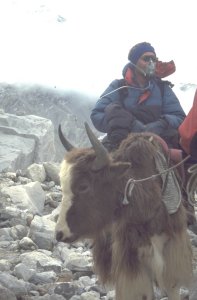
In such an ordered way, one sits on a yak only for the first five minutes.
The way is long and boring, we travel from half past eight to half past one. Sometimes it is pretty steep, and I have to take care not to fall from the back of the yak.From the yak's back, I come to the conclusion that these strange animals walk without any purpose. Mostly they try to push through the others, until someone gives in, and something like an ordered row establishes again. Obviously they never heard about making reasonable use of the terrain - they just go wherever they want, not caring if it is the way or just a stone heap. An incredible miracle, how the caravan can in the end arrive at its destination. A clear advantage, from my position on the yak, are river crossings.
Shortly before reaching the Chinese base camp, in fact the liaison officer meets us in his jeep, as we had hoped for. And, the first five persons can continue to Tingri without a break at the Chinese camp. In Tingri, we wait for the others, especially the material tons, until late night. At least, we are in a manner of speaking back in civilization.
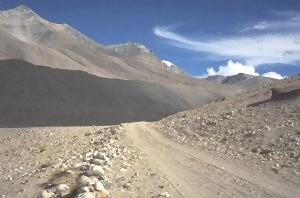
On the way back towards civilization
Tuesday, May 25, 1999
Tingri - Nyalam - Zhangmu - Kodari - KathmanduAfter an early breakfast we have a trouble free trip through a scenery that has become green in many regions. Everywhere people are working on the barley fields. At the Himalayan main crest, many clouds show up, has Monsoon already arrived? The road between Nyalam and Zhangmu also shows that it was raining during the days before. The landslide damages are already repaired, and it's just a mud trace now, but still ok for the vehicles. In Zhangmu, meanwhile really changes have taken place: The truck wreck that had been stuck hopelessly deep in the mud of the main street has disappeared.
Customs control is very quick, but there is a one-hour delay on the road down to Friendship Bridge: A truck apparently was overloaded and got stuck, and now all its load has to be transferred to another truck waiting above. After that was finished it takes some time until the traffic jam is solved. Obviously it is a disadvantage that on this road in no man's land apparently nobody knows if the right side (China) or the left side (Nepal) traffic is valid.
The unpaved road to Barabise takes endless time, and when we reach the Kathmandu valley dusk has already fallen in. That again reduces speed, because nobody uses his light before it is completely dark. The very last ones to switch on the headlights are the motorbikes, pushing through around the other vehicles everywhere. Seeing that, the driving style is similar to the yaks (just overtake, the others will take care), the way back is pretty stressful for our bus driver. After a brief confrontation with a policeman who discovered the particular importance of some special traffic regulations half a kilometer from our destination, we finally reach the hotel Yak & Yeti at nine o'clock in the evening.
Unlike other countries like e.g. Argentina, in Nepal dinner time is rather early, but the buffet fortunately is open until half past ten.
Wednesday, May 26, 1999
Kathmandu - Frankfurt - LeustettenGetting up early again. The agency was able to reserve two places on the next flight back home for Claudia and me; according to schedule we should have stayed another two days in Kathmandu taking the Friday morning flight. It is better for me, however, to take the earlier flight, so I can have a health check in hospital at home. At six in the morning we are brought to the airport, at eight finally the airport procedure is done, and at nine we are leaving Nepal. Once more a stop in Dubai, and at five in the evening we reach Frankfurt, at half past ten Friedrichshafen, and at eleven we are back home - 21 hours after our departure from Kathmandu.
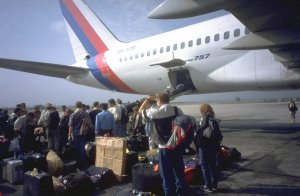
In Kathmandu, everybody has to put his baggage on the plane directly. Probably, instead one can avoid the x-ray investigation.
Supplement
One has to ask the question why everything evolved so quickly into that life-threatening situation during the descent.During the morning in camp 2 - according to my coordination problems - I probably had HACE (high altitude cerebral edema). But that should quickly have improved during descent, especially of course in base camp, after the dehydration was fixed. General exhaustion added to the problem, but also a bronchial infection. (otherwise the exhaustion wouldn't have been that pronounced). But it's completely unclear where I got the bronchial infection from, because my cough (also my quite penetrate altitude cough) had completely disappeared some days before the summit attempt. But that might only mean that at that point my immune system was working well and - unnoticedly - had taken care of the already existing infection. After the exhausing summit day, there were no more reserves for that, and the infection broke out simultaneously with the exhaustion, and so it all came together.
In Germany, I spent two days in the hospital (for observation). After other damages, especially a pulmonary embolism, could be excluded, I was able to return home again to cure the after-effects of edema, lung- and circulation strains and dehydration.
Besides that I suffered minor frostbite (grade I) on the hands and feet that have since been completely cured (July 1999); the dead feeling in the fingers and the toes completely disappeared within six weeks.
Thanks
Without the intense help of my comrades I would not be sitting here and writinge this text. Robert Rackl, Michael Beuter and the Sherpas Chuldim, Ang Phurba und Nawang, who were equipped with almost unlimited power, were the deciding factors in my rescue. Our fast Swiss Thomas and Martin quickly got the essential medicine from the base camp; many members of our and the British O.T.T. expedition helped carry me or filled other useful functions that I couldn't appreciate enought in that situation. Chilean veterinarian Vivien and Austrian ambulance attendant Theo Fritsche took care of the medical support; I am grateful to Petra Kluger, Thomas Zwahlen, Martin Bischoff, Christian Rottenegger for the important night watch that first night, and during the following day to Claudia Bäumler who devotedly looked after me.At home in the hospital, Dr. Georg Kunze achieved that I was quite soon fit for everyday life and that I won't have to worry about any permanent damage. In case I forgot anybody here, please tell me or be content with the general name "group" - there were surely many things that I didn't realize in my condition therefore I can not acknowledge all things properly, as important as they might have been.
Also besides this rescue operation, I believe that we all together, no matter if from the Amical or the Augsburg sub-groups, made up a very harmonic team. It needs a certain amount of luck to make things work that well, and we had quite a lot of that. It also needs a competent and good expedition leader: "Our own" man (Michael) did an excellent job. Amical group leader Robert would definitely do everything for his people if they had problems.
Strictly speaking, Robert was the hero of this year's Cho Oyu season - he brought down the Spaniard from camp 2, accompanied two sick Austrians from camp 2, and in the end helped with my time- and power-consuming rescue. For him (being a good expedition leader) it was no problem that he didn't reach the summit, since seven out of ten Amical participants that attempted the summit were successful (and three of the six Augsburg members).
It was almost a triviality that the agency in Kathmandu did a perfect job. We can recommend Thamserku with conviction to anyone who plans a trek or expedition in Nepal or Tibet.
Our German Alpine Club section (Überlingen/Bodensee) gave us financial support for this expedition.
Remarks - safety at 8000 and 7000 m peaks
I have learned several things during this expedition:- 8000 m peaks inherently include, compared to 7000 m peaks, seriously higher health risks.
- These risks are (see my case) not easily visible, even if one has intensely prepared for acclimatization problems. We were perfectly acclimatized for the base camp (a pulse like at home), but a dormant infection can hardly be discovered beforehand.
- The risks mentioned above can evolve into massive problems in a completely unexpected situation.
- The transport of a person unable to walk from above 7000 m is possible only with big effort. A small expedition of 6 persons or so could rescue one of its members only under the very best conditions. The larger the group, the larger the availability of rescue helpers in a case of emergency.
- Sherpas as high altitude porters substantially increase the safety of an expedition. Even the best-acclimatized foreign mountaineer can not compete with a well-trained Sherpa. Therefore, Sherpas are indispensable at 8000 m peaks expeditions as a safety fact.
- On mountains like Cho Oyu, where a large number of expeditions act at the same time, an expedition without Sherpas can fall back on the Sherpa teams from other expeditions in case of urgent need, being only a financial (and also moralic) question.
- Maybe I forgot this triviality: The maximum reachable altitude for helicopters is about 5800 m due to technical reasons. At Cho Oyu, one therefore could just reach the base camp; the nearest helicopter would in fact be near Namche Bazar, but it cannot cross the Chinese border. Chinese helicopters, however, are not available. So the only alternative is the long way out on surface to the Chinese base camp and to Tingri.
- I personally would try to avoid attempting less frequently visited high mountains without high altitude porter Sherpas, less for comfort but for safety reasons. The transport of a person unable to walk over scree terrain involves about 20-40 persons. The less helpers that are available, the more each one has to work. It can not be imagined how much a work the Sherpa can do when carrying loads, if one hasn't directly seen it.
- Summarized: At Cho Oyu it might not very quiet, but in the case of an emergency quickly enough people can be found to help. I am thankful that all these people were there and I don't want to imagine how my situation would have evolved on a "lonely" mountain.
Footnotes
[1] Nepal time = Central European Summer Time + 3:45, so that is 6:15 CEST (back)[2] Taxi round trip (including 2 h waiting for us in Bhaktapur) Rs. 600(back)
[3] Rice with lentil sauce, the Nepalese standard dish.(back)
[4] in all over China, Beijing time is used (=CEST+6:00). Leave it open how happy people in Sinkiang might be with a sunrise time of 11 a.m. (back)
[5] The Sherpa team consists of cook Rinji, Sirdar Nawang, the two high porters Chuldim und Ang Phurba, kitchen boy Pasang and Tibetan kitchen helper Lakpa. While our group is being supplied with meals as the Amical group, our "package" doesn't include high altitude porters service. (back)
[6] Nangpa La (5700 m) is the most prominent pass in this region of the Himalayan main crest. In the middle age, the today's Sherpa people had immigrated to the Khumbu region over this pass. Nowadays, Tibetan yak caravans regularly cross the pass on the way to and from the market in Namche Bazar.(back)
[7] The Puja ceremony has the purpose to make the Gods gracious to Sherpas and mountaineers. Going beyond base camp before the Puja could provoke accidents. Sirdar (Sherpa group leader) Nawang is also a lay priest.(back)
[8] The "killer slope" is the 350 m high, steep scree pile that must be conquered directly before reaching camp 1. The name is meant ironically and indicates the disastrous effect on the psyche that this loose stuff has, especially because the slope gradually inclines backwards towards the top.(back)
Comments on the heights of the camps
As there are quite different opinions about the heights of the camps, we wanted to calculate back especially the base camp altitude from the measured summit altitude. We first based our assumptions on a base camp altitude of 5650 m; at the summit, however, all altimeters showed a height of about 8000 m instead of 8201 m. That would mean that the base camp would be 200 m lower. Since with Nangpa La a well-surveyed point with 5700 m is in sight from the base camp, that difference is too striking to be unnoticed throughout all our long stay in base camp. The difference of the summit height can not completely be attributed to the weather and therefore remains unclear. We base our assumptions on a height of 5700 m for the base camp and calculate all high camps from there. The summit day will therefore contain a mistake of at least 100 meters.Home |
Back to "Mountains" |
Back to "Expeditions" |
Cho Oyu 1997 |
Map sketch |
Height diagram |
Deutsche Version |
 Slideshow |
print version (no menus) |
Hartmut Bielefeldt
Sonnhalde 8
D-88699 Frickingen
© 1999 Hartmut Bielefeldt
![]() This page is confirmed to comply with the HTML 4.0 standard.
This page is confirmed to comply with the HTML 4.0 standard.
First version of this text published 07 August 1999.
Thanks to Stacy Necessary for kindly checking my English grammar and spelling.
Text last updated 28 October 1999 by Hartmut Bielefeldt